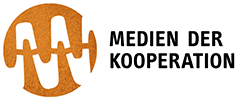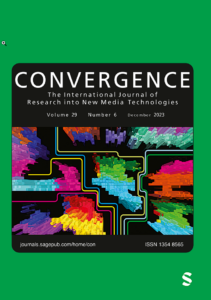A03 - Navigation in Online/Offline Spaces
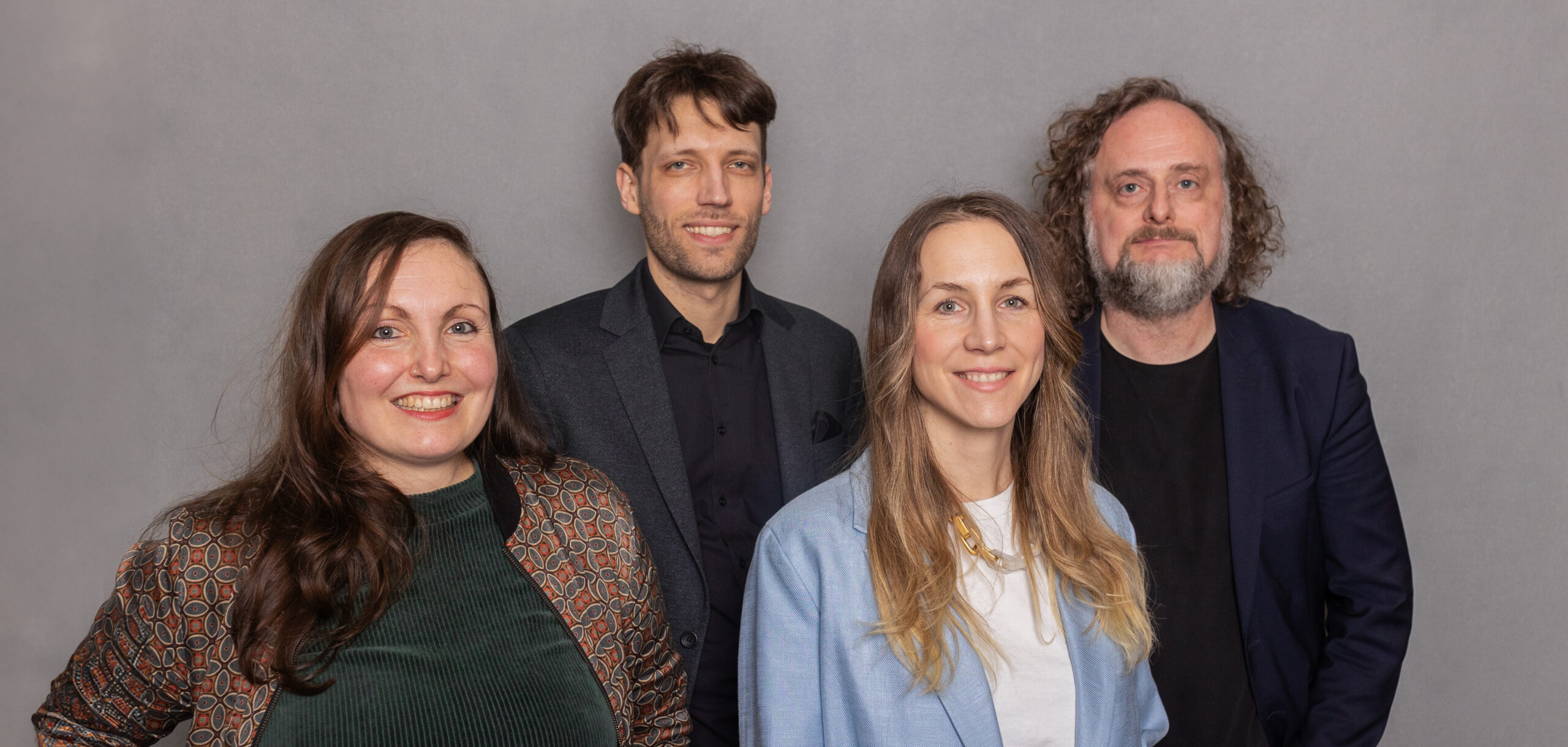
Principal Investigators:
Researchers:
„The project is dedicated to the media-theoretical question of how media and spaces are produced cooperatively through navigational practices. To this end, it examines the interplay of motile and mobile components of sensor-loaded urban micronavigation.“
Executive summary
The sub-project is dedicated to the media-theoretical question of how media and spaces are brought about cooperatively through navigational practices. After A03 dealt with transforming navigation applications to social media and platforms in the first phase, the second funding phase focused on semi-autonomous navigation processes. In the third funding phase, the sub-project examines decision-intensive, media-supported navigation situations in urban areas characterized by an infrastructure loaded with sensor technology. In the literature on the "“Internet of Things”, this mode of mobility is also described as context-related micronavigation. Micronavigation is defined as a form of movement characterized by common data, media and spatial practices, in which transport media and modes are used relatively briefly or changed frequently. The aim of the sub-project is to analyze and theoretically describe the cooperative production of data, media and space practices in micronavigation across online and offline worlds. Focus of the project is empirically researching two forms of navigation: micronavigation with the help of augmented reality devices and micronavigation with e-bikes/scooters in urban areas. Using inventive methods, the project examines how both case studies attempt to create transitions that are as seamless as possible between online- and offline spaces, between means of transport, apps, but also the human and technical sensorium. A03 asks how sensor-intensive navigation media measure and calculate bodies, movements and surroundings and thereby platform urban space, e.g. by integrating their data into political mobility discourses and – ostensibly sustainable – urban infrastructure planning. Based on the analysis of micromotility with local media and micromobility in the urban vicinity, the sub-project is able to develop a common spatial and media theory of micronavigation. Through its empirical case studies, it also specifies a sensor-media understanding of (platform-) media as “environing media.”
A03 investigates micro-navigation in urban spaces.
We define micro-navigation as a form of mobility in which various media and modes of transport are used over short distances, situationally and in close proximity to the body. Micro-navigation is characterised by an intensive entanglement of media, data and spatial practices. A03 studies these practices in urban spaces, focussing on how micro-navigation unfolds with augmented reality apps and glasses, as well as with e-bikes and e-scooters. In doing so, the project aims at:
- Defininging the relationship between media-supported motility and mobility practices in the context of urban navigation
- Developing a media theory of micronavigation that focuses on seamlessness as a situated accomplishment and socio-technical imaginary
- Expand the platform concept for "Environing Media".
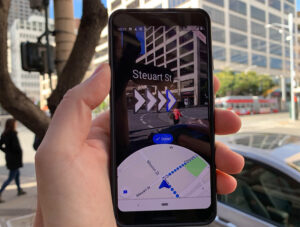
(© Google)
To account for the specificity of its research objects, A03 combines methods into Inventive Mixed Methods, building on and expanding proven material-semiotic approaches as well as on praxeological and (sensor-) ethnographic methods for researching multimodal micro-navigation processes. The project will enhance "Sensory Digital Methods" to enquire into the background cooperation characterising the sensor media and platforms used in urban navigation.
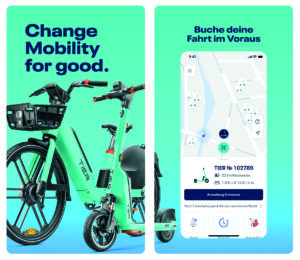
(© Google Playstore)
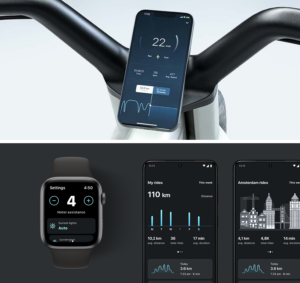
(© VanMoof Blog)
WP1 "Micromotility with Proximate Media" examines the motile component of urban micro-navigation along the example of smart glasses, AR apps and wearables [1] from a historical perspective, [2] praxeologically, and [3] with regard to the imaginaries of seamlessness, maplessness and framelessness.
WP2 "Micromobility in Proximate Spaces" studies urban micro-mobility by means of e-bikes/scooters with a focus on [1] software & infrastructures, [2] practices, and [3] platformisation.
WP3 "Sensory navigation in online/offline spaces" reflects on methodological approaches and consolidates the results of the case studies. WP3 will make three theoretical key contributions:
- Refine the qualitative understanding of data
- Develop a praxeology of distributed immersion
- Synthesise a sensory platform theory of micro-navigation
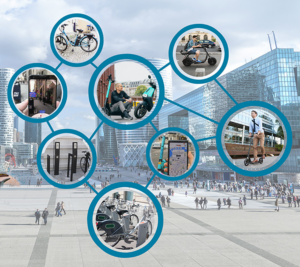
(© micromobility.io)
➔ Find the project archive 2020–2023 here
Publications
Current
„Digital methods for sensory media research: Toolmaking as a critical technical practice“
‘Digital methods’ turn to medium-specific and online avenues for social and cultural research. While these approaches foster empirical media studies, it has become increasingly challenging to ‘follow the medium’ and ‘repurpose’ its methods. The prominence of sensory media such as ‘smart’ networked devices (e.g. mobile phones) in mundane practices and their infrastructural dependencies confront media scholars with highly contingent objects of study.
Yet, studying such sensor-based devices is crucial, for they enable continuous and unnoticed monitoring of everyday (inter)activity. The article suggests that developing digital methods for sensory media can be understood as specific ‘critical technical practice’ (CTP) by engaging with two toolmaking stories. It draws on and emphasises the fundamental similarity between CTP and digital methods which both aim at conjoining technical engagement and understanding with methodological reflection. The toolmaking stories explicate the making of and the limitations to developing digital methods for increasingly obfuscated mobile sensory media, exploring the possibilities of repurposing their functionality and data. They include building tools for app code analysis focused on apps’ capacity to track sensor data, as well as for ‘sensing’ and analysing network traffic of mobile devices in use. The featured toolmaking then unravels distinctive research affordances, that is, action possibilities for ‘static’ and ‘dynamic’ modes of analysis grappling with the technicity of mobile sensory media and their data. We argue that toolmaking as CTP for sensory media studies implies engaging with these media as entangled infrastructures, examining not just their social, but also their technical ‘multi-situatedness’. This involves investigating the ‘liveliness’ of their data, or how it is generated, processed and made sense of. In conclusion, we discuss implications for ‘doing digital methods’ in sensory media research. Toolmaking itself becomes an inevitable form of media research and critique, inviting and challenging researchers to deploy the media’s situatedness for their investigations.
Chao, Jason; Daniela van Geenen; Carolin Gerlitz und Fernando N. van der Vlist. 2024. “Digital methods for sensory media research: Toolmaking as a critical technical practice”. Convergence. Special Issue: Critical Technical Practice(s) in Digital Research 0 (0): 1-28. https://doi.org/10.1177/13548565241226791.
